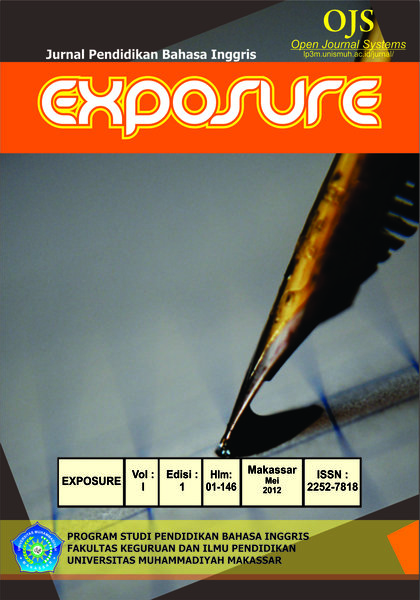DOUBLE ENTRY JOURNAL TECHNIQUE FOR THE STUDENTS’ READING COMPREHENSION
DOI:
https://doi.org/10.26618/exposure.v1i1.762Abstrak
The objective of the research is to know the improvement of the students’ reading comprehension using double entry journal technique at the second year students’ of SMA Neg. 1 Pasui. This research is a classroom action research consist of two cycles, the mean score of the students’ reading comprehension for diagnostic-Test is 5.95 which is categorized as poor classification. While the mean score of the students’ reading comprehension in cycle I was 6.39. It is higher than the students’’ D-Test. But the result was still not significant because it is still categorized as fair and under the KKM 60. So the research is continued to the cycle II and the mean score of the students’ reading comprehension of cycle II was 6.82. Having analyzed the data, it can be stated that the students’ reading comprehension at the second year in class XI of SMA Neg.1 Pasui is poor level before applying the double entry journal technique, but after applying the technique in the second cycle, the students’ reading comprehension is classified as good categories.
Referensi
Bruchac, Joseph, and Francisco Jimenez. 2008. Double-Entry Journal. Annenberg Media. Retrieved from http://www.learner.org/channel/workshops/tml/workshop8/teaching.html 12:48, on 26 May 2000.
Cobine, Gary. 1995. Effective Use of Student Journal Writing. Eric Digest.
Depdikbud, 1985. Garis-garis Besar Program Pelajaran Mata Pelajaran Bahasa Inggris Kurikulum Sekolah Menengah Umum. Dirjen Dikdasman
Gay, LR, 1981. Educational Research Competencies for Analysis & Application. Second Edition, London: Longman.
Grellet, Francoise. 1981. Developing Reading Skills. Cambridge: Cambridge University Press.
Hafidz, F.Mand Tudor. 1989. Extensive Reading and the Development of Language Skills. England: Oxford University Press.
Harmer, Jeremy. 1991. The Practice of English Language Teaching. London, Longman Group.
______ .2008.WETA Washington, D.C. Double-Entry Journals. Retrieved from http://www.adlit.org/strategies/22091. 1:05, on 10 September 2009.
Hornby A.S, 1986. Oxford Advanced Dictionary of Current English. Great Britain: Oxford University Press.
Irawati, 1990, Developing Reading Comprehension. Kencana Prenada: Jakarta
Layman. 1972. Teaching in testing. New York: Oxford University Press.
Lutfiah, 2007. The Achievement students reading comprehension through Cooperative Learning
Margarita Calderon, Gary Ivory, Robert E, Slavin. 1997. Effects of Bilingual Cooperative integrated reading and composition On students transitioning From Spanish to English reading. (Online) Retrieved from http://www.csos.jhu.edu/crespar/techReports/Report10.pdf, on 20 September 2011.
McCarty. 1999. Efficient reading a particle quite. Sidney: Mc. Graw Book Company
Sheldon, Leslie E. 1988. Evaluating ELT Textbooks and Materials. ELT Journal Volume 42/4 October 1988. Oxford University Press.
Simanjuntak, 1998. Developing Reading Skill for EFL Students. Jakarta: Depdikbud.
Sudjana. 1999. Metode statistika. Bandung: PT. Gramedia.
Unduhan
Diterbitkan
Terbitan
Bagian
Lisensi
Authors who publish with this journal agree to the following terms:
In order to assure the highest standards for published articles, a peer review policy is applied. In pursue of the compliance with academic standards, all parties involved in the publishing process (the authors, the editors and the editorial board and the reviewers) agree to meet the responsibilities stated below in accordance to the Journal publication ethics and malpractice statement.
Duties of Authors:
- The author(s) warrant that the submitted article is an original work, which has not been previously published, and that they have obtained an agreement from any co-author(s) prior to the manuscript’s submission;
- The author(s) should not submit articles describing essentially the same research to more than one journal;
- The authors(s) make certain that the manuscript meets the terms of the Manuscript Submission Guideline regarding appropriate academic citation and that no copyright infringement occurs;
- The authors(s) should inform the editors about any conflict of interests and report any errors they subsequently, discover in their manuscript.
Duties of Editors and the Editorial Board:
- The editors, together with the editorial board, are responsible for deciding upon the publication or rejection of the submitted manuscripts based only on their originality, significance, and relevance to the domains of the journal;
- The editors evaluate the manuscripts compliance with academic criteria, the domains of the journal and the guidelines;
- The editors must at all times respect the confidentiality of any information pertaining to the submitted manuscripts;
- The editors assign the review of each manuscript to two reviewers chosen according to their domains of expertise. The editors must take into account any conflict of interest reported by the authors and the reviewers.
- The editors must ensure that the comments and recommendations of the reviewers are sent to the author(s) in due time and that the manuscripts are returned to the editors, who take the final decision to publish them or not.
Authors are permitted and encouraged to post online a pre-publication manuscript (but not the Publisher’s final formatted PDF version of the Work) in institutional repositories or on their Websites prior to and during the submission process, as it can lead to productive exchanges, as well as earlier and greater citation of published work (see The Effect of Open Access). Any such posting made before acceptance and publication of the Work shall be updated upon publication to include a reference to the Publisher-assigned DOI (Digital Object Identifier) and a link to the online abstract for the final published Work in the Journal.

